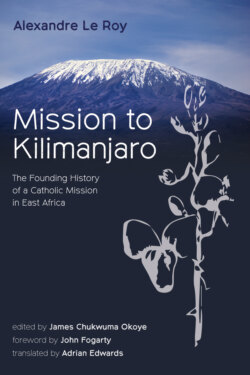Читать книгу Mission to Kilimanjaro - Alexandre Le Roy - Страница 6
На сайте Литреса книга снята с продажи.
Foreword
ОглавлениеThe late Fr. Adrian Edwards, C.S.Sp., renowned author and anthropologist, has provided a wonderful service in carefully translating into English the classic missionary ouvrage of Mgr. Alexandre Le Roy, C.S.Sp., Au Kilima-Ndjaro, first published in French in 1914, thus making the publication available to a wider contemporary audience. As an experienced missionary and academic, Fr. Edwards clearly saw the importance of this work in the history of missiology, and its translation, completed shortly before his unexpected death in 2017, effectively serves as his final legacy to the mission of evangelization to which he dedicated his life and talents.
Mgr. Le Roy, an intrepid missionary, accomplished ethnologist, and artist, had a profound interest in, and a deep love of and respect for, the people he encountered on his extensive travels, as well as their culture, customs, values, and artwork, an approach which shaped his vision and strategy for evangelization at a time when many of his contemporaries shared a significantly narrower worldview. His classic work, Au Kilima-Ndjaro, is a fascinating account of the arduous journey into the East African interior undertaken in July 1890 by the author and two other members of the Congregation of the Holy Spirit, Fr. Auguste Gommenginger and Bishop Jean-Marie de Courmont, together with their entourage of almost 300 men, from the initial base at Bagamoyo on the coast, founded in 1868. With his unique insights and perspective, Le Roy describes in graphic detail the various stages of the almost six-week journey, the internal organization of the group for maximum efficiency, his impressions of the region, and the people along the way, together with the difficulties encountered which included inadequate water, illness, and threats from wild animals in the unchartered territory of the semi-arid Maasai steppe. His memoirs culminate in the striking description of their final destination, the majestic snow-capped peak of Kilimanjaro, which clearly evoked awe and amazement in Le Roy and his companions:
The spectacle we have before our eyes is something that will remain unforgettable. Underneath a completely blue sky, there in front of us, we see the immense profile of the marvelous mountain. The two peaks [Kibo and Mawenzi] appear to be supported by this enormous pedestal . . . as a candelabra lit in the course of centuries to the glory of the Creator.1
As noted by the African historian, Matthew V. Bender,2 the subsequent sixty years of Spiritan missionary activity on the slopes of Mount Kilimanjaro saw the establishment of one of the largest and most prosperous Catholic communities on the continent of Africa. In addition to the founding of dozens of mission stations among the Chagga people, the economic and social landscapes of the mountain were transformed through the establishment of schools and hospitals and the cultivation of Arabica coffee, which became a lucrative business for the population, to the extent that the region had the highest ratio of schools to students, the highest school enrollment figures, and the most medical facilities per capita in any part of rural Eastern Africa.
I have no doubt that this publication, available in English for the first time, will be of considerable interest to historians and missiologists alike, as well as to the general public at a time of increasing research into African history and culture.
John Fogarty, C.S.Sp.
Superior General
1. Bender, “Holy Ghost in the Highlands,” 69.
2. Bender, “Holy Ghost in the Highlands,” 69-89.
